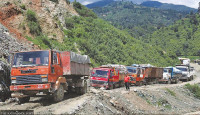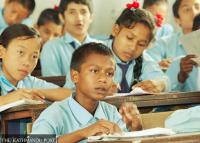Opinion
Untapped potential
To capitalise on Nepal’s unprecedented demographic dividend, the country needs to invest in its young
Giulia Vallese
Last month, I had the opportunity to meet three adolescents from Dang, Kapilvastu, and Sindhuli, respectively. Their insights and understanding were striking as they described the demographic transition Nepal is going through and the importance of putting young people at the heart of the development agenda in Nepal. In a video interview, they also narrated how they have been advocating sexual and reproductive health, the rights of adolescents, fighting against harmful practices including child marriage, and lobbying for the participation of young people in development processes in their respective hometowns.
A powerful force
Yesterday, the United Nations Population Fund (UNFPA) launched its global flagship report, the State of World Population 2014, titled ‘The power of 1.8 billion: Adolescents, youth and the transformation of the future’. The report explains that developing countries like Nepal, with large youth populations, could see their economies soar, provided they invest heavily in young people’s education and health and protect their rights.
Today’s 1.8 billion young people are a powerful force, individually and collectively. They are shaping social and economic realities, challenging norms and values, and building the foundation of the world’s future. Never before have there been so many young people. Never again is there likely to be such a potential for economic and social progress. How we meet the needs and aspirations of young people will define our common future. Young people matter because they are the shapers and leaders of our global future. And they matter because they have inherent human rights that must be fulfilled.
UNFPA’s Executive Director and UN Under-Secretary-General Babatunde Osotimehin, while launching the report, called on countries in pursuit of a demographic dividend to ensure the gains result in growth that benefits everyone. He gives us an example of just how powerful and transformative young people could be if countries invested in them in the right ways. In the 1950s and 1960s, several East Asian economies invested heavily in young people’s capabilities and in expanding their access to voluntary family planning, enabling individuals to start families later and have fewer children. The result was unprecedented economic growth. The Republic of Korea, for example, saw its per-capita gross domestic product grow about 2,200 percent between 1950 and 2008.
Reaping the dividend
Nine out of 10 of the world’s young people today live in less developed countries, according to the report. Because of lagging social services, these countries face greater obstacles to leveraging the advantages that can result from engaging a youthful, productive workforce. The report shows that demographic shifts taking place in about 60 countries are opening a window for a demographic dividend, whose size largely depends on how those countries invest in young people to realise their full potential.
If Nepal makes the right investment in young people, enabling them to participate in decisions that affect their lives and adopting policies to bolster economic growth, the demographic dividend up for grabs can yield enormous economic and social returns. According to the report, a demographic dividend of this magnitude has the potential to lift people out of poverty, raise living standards, and catapult economies forward. Critical youth investments needed to reap a demographic dividend are those that protect rights, including reproductive rights, improve health, including sexual and reproductive health, and provide skills and knowledge to build young people’s capabilities and agency. These investments can also accelerate a decline in fertility, which in turn can accelerate the demographic transition.
Right now, Nepal has the largest productive youth population compared to the dependent population in its history. About 35 percent of the population is below the age of 15 while 57 percent are between the productive ages of 15-59 years and another 25 percent are expected to reach the working age within a decade. This is a huge opportunity. These figures will prevail for a limited period and the window of opportunity that Nepal currently has might close within the next 20-30 years. Therefore, to maximise the dividend, Nepal must ensure that its young working-age population is equipped to seize opportunities for jobs and other income-earning possibilities.
The 1994 International Conference on Population and Development (ICPD) in Cairo, which Nepal is a signatory to, has redefined the meaning of population for development planning. Thus, proper investment in this large cohort can reap enormous benefits and help Nepal take advantage of its demographic transition. But for this, sound investments need to be made to provide decent job opportunities and to have educated and healthy individuals that can positively contribute to society. The many young people who were involved in various activities to celebrate this year’s World Population Day in different parts of Nepal on July 11 have a point in calling for more investment in and for them.
Towards sustainable development
Since we now have the largest generation of young people, there can be no talk of sustainable development without adequate investments in their health, education, and employment, without empowering them, equipping them with skills, agency, and resilience. We cannot talk about sustainable development without ensuring that young people’s needs are met, that we give voice to their aspirations, and that we include them in decision-making. And we cannot talk about sustainable development without addressing women’s empowerment, gender inequality and discrimination, and violence. Finally, we cannot talk about sustainable development without ensuring the sexual and reproductive health and rights of all.
This is why young people, including adolescent girls, are at the heart of our work at UNFPA. Working with a multitude of partners, in particular young people themselves, we advocate policies, strategies, and programmes that invest in adolescents and youth and foster a positive environment for them; promoting their access to comprehensive sexuality education as well as quality sexual and reproductive health services, including family planning; and facilitating their leadership and participation in decision making. We are doing this with an emphasis on reaching the poorest, most marginalised and underserved adolescent girls.
Through this multipronged effort, we and our partners are seeing how critical early investments in sexual and reproductive health can enhance the lives of young people and the welfare of their societies. I reiterate that a sustainable future depends on having resilient populations, which cannot be achieved without investments in young people. I believe that with the right policies and investments in human capital, Nepal can empower young people to drive economic and social development and boost per-capita income.
Vallese is UNFPA Representative to Nepal




 15.12°C Kathmandu
15.12°C Kathmandu










